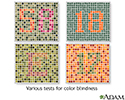Color vision test
Eye test - color; Vision test - color; Ishihara color vision test
A color vision test checks your ability to distinguish between different colors.
How the Test is Performed
You will sit in a comfortable position in regular lighting. The health care provider will explain the test to you.
You will be shown several cards with colored dot patterns. These cards are called Ishihara plates. In the patterns, some of the dots will appear to form numbers or symbols. You will be asked to identify the symbols, if possible.
As you cover one eye, the tester will hold the test cards 14 inches (35 centimeters) from your face and ask you to quickly identify the symbol found in each color pattern.
Depending on the problem suspected, you may be asked to determine the intensity of a color, especially in one eye compared to the other. This is often tested by using the cap of a red eyedrop bottle.
How to Prepare for the Test
If your child is having this test performed, it may be helpful to explain how the test will feel, and to practice or demonstrate on a doll. Your child will feel less anxious about the test if you explain what will happen and why.
Usually there is a sample card of multicolored dots that almost everyone can identify, even people with color vision problems.
If you or your child normally wears glasses, wear them during the test.
Small children may be asked to tell the difference between a red bottle cap and caps of a different color.
How the Test will Feel
The test is similar to a vision test.
Why the Test is Performed
This test is done to determine whether you have any problems with your color vision.
Color vision problems usually fall into two categories:
-
Present from birth (congenital) problems in the light-sensitive cells (cones) of the
retina
(the light-sensitive layer at the back of the eye) -- the color cards are used in this case
Retina
The retina is the light-sensitive layer of tissue at the back of the eyeball. Images that come through the eye's lens are focused on the retina. Th...
 ImageRead Article Now Book Mark Article
ImageRead Article Now Book Mark Article - Diseases of the optic nerve (the nerve that carries visual information from the eye to the brain) -- the bottle caps are used in this case
Normal Results
Normally, you will be able to distinguish all colors.
What Abnormal Results Mean
This test can determine the following congenital (present from birth) color vision problems:
-
Achromatopsia -- complete
color blindness
, seeing only shades of gray
Color blindness
Color blindness is the inability to see some colors in the usual way.
Read Article Now Book Mark Article - Deuteranopia -- difficulty telling the difference between red/purple and green/purple
- Protanopia -- difficulty telling the difference between blue/green and red/green
- Tritanopia -- difficulty telling the difference between yellow/green and blue/green
Problems in the optic nerve can show up as a loss of color intensity, although the color card test may be normal.
Risks
There are no risks with this test.
References
Adams AJ, Verdon WA, Spivey BE. Color vision. In: Tasman W, Jaeger EA, eds. Duane's Foundations of Clinical Ophthalmology . 2013 ed. Philadelphia, PA: Lippincott Williams & Wilkins; 2013:vol.2, chap 19.
American Academy of Ophthalmology Preferred Practice Patterns Committee. Preferred Practice Pattern Guidelines. Comprehensive Adult Medical Eye Evaluation -- 2010. http://one.aao.org/preferred-practice-pattern/comprehensive-adult-medical-eye-evaluation--octobe. Accessed June 26, 2013.
Schor NF, Behrman RE, eds. Nelson Textbook of Pediatrics . 19th ed. Philadelphia, PA: Elsevier Saunders; 2011:chap 611.
-
Color blindness tests - illustration
Color blindness is the inability to distinguish the differences between certain colors. The most common type is red-green color blindness, where red and green are seen as the same color. Usually Ishihara (pseudoisochromatic) plates are used to test color vision. They are made of dot patterns composed of primary colors. These dot patterns represent a symbol that is superimposed on a background of randomly mixed colors. The test can determine certain abnormalities in a person's color vision.
Color blindness tests
illustration
-
Color blindness tests - illustration
Color blindness is the inability to distinguish the differences between certain colors. The most common type is red-green color blindness, where red and green are seen as the same color. Usually Ishihara (pseudoisochromatic) plates are used to test color vision. They are made of dot patterns composed of primary colors. These dot patterns represent a symbol that is superimposed on a background of randomly mixed colors. The test can determine certain abnormalities in a person's color vision.
Color blindness tests
illustration
Review Date: 2/23/2015
Reviewed By: Franklin W. Lusby, MD, ophthalmologist, Lusby Vision Institute, La Jolla, CA. Also reviewed by David Zieve, MD, MHA, Isla Ogilvie, PhD, and the A.D.A.M. Editorial team.

